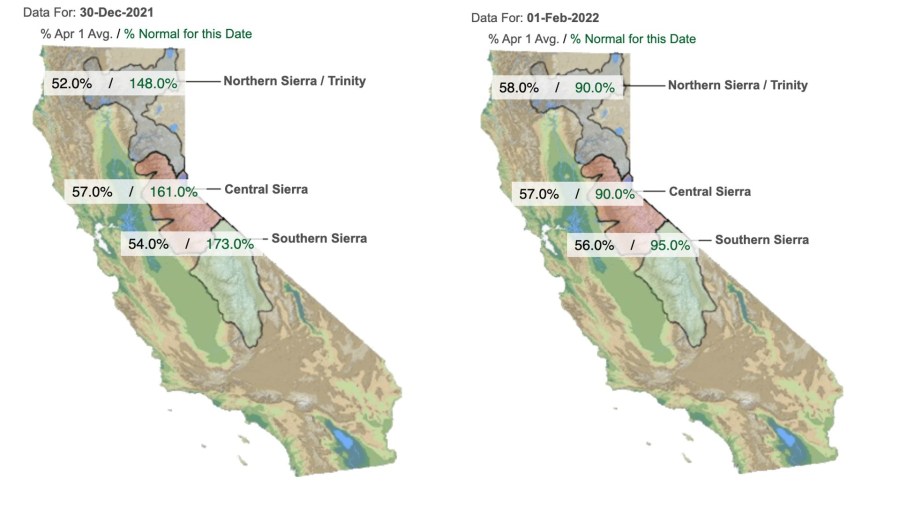California’s snowpack is now below average for this time of the year following a dry January, a dramatic turn from the previous month when the Sierra Nevada was inundated with record amounts of snow.
As of Tuesday, the snow water content measured 90 to 95% of normal across the Sierra range, with the statewide average hovering around 92%, according to the California Department of Water Resources.
The new figures reveal a staggering reversal from the end of December, when the state’s ever-dwindling snowpack was replenished by a barrage of storms that brought record-setting snow to parts of the Sierra.
During the season’s first snowpack survey, conducted at Phillips Station on Dec. 30, the snow water equivalent was found to be roughly 160% of normal for the end of the year — the highest figure measured for that time in over a decade.
You can see the difference between the northern, central and southern Sierra between the end of December and today below:

The shrinking amount of water was due to an exceptionally dry January, a month that is traditionally among the wettest in California.
“Amid record-dry Jan across portions of Sierra Nevada, California snowpack has now fallen below avg for date–remarkable given it was ~160% of avg for date in late Dec!” Daniel Swain, a climate scientist at UCLA, tweeted Monday.
With dry conditions expected to persist over the next two weeks, Swain said the percentages will continue their precipitous decline.
Swain also noted that it’s not just the lack of rain and snow alone that is causing the snow water content to deplete: “It has also been much warmer and sunnier than usual at high elevations in Jan–leading to substantial mid-winter snowmelt (so there is active loss of snowpack, not just stalling of growth),” he tweeted.
The snowpack provides about about a third of California’s water supply once it melts and runs into reservoirs, which is why the numbers are so critical.
The latest federal drought monitor map continues to show California is mired in drought, with almost two-thirds of the state experiencing severe drought. Still, that represents a vast improvement from about six weeks ago, when about 80% of the state was in one of the two worst drought categories — exceptional or extreme.
“We are definitely still in a drought. A completely dry January shows how quickly surpluses can disappear,” DWR Director Karla Nemeth said in a statement after the department conducted its second snowpack survey of this winter. “The variability of California weather proves that nothing is guaranteed and further emphasizes the need to conserve and continue preparing for a possible third dry year.”













